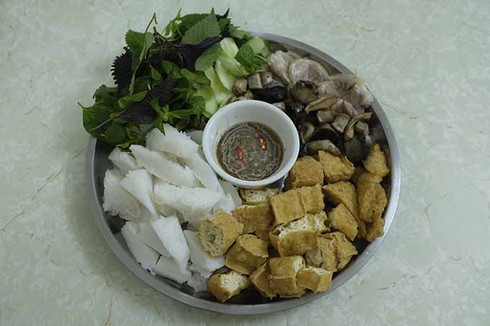When people talk about food in Hanoi, they normally mention pho, bun cha and green rice as some of the essential features of the thousand year old capital, but bun dau mam tom, a simple dish consisting of soft rice noodles, fried tofu and fermented shrimp sauce has also earned its place in the city’s culinary history.
The famous street food dish is a must-try for its uniqueness and simplicity that cannot be found elsewhere, but many foreigners are unable to stand the smell of the potent sauce. The popular dish can be found on almost every corner of the city, and is a popular choice for lunch here.
To get a better understanding of bun dau mam tom, Trung Huong on Phat Loc Alley in Hoan Kiem District is the place to go.
At noon on a sunny day, the acclaimed restaurant is filled with hungry customers. The alley was full of motorbikes. Inside, there was only one table left as the the busy staff quickly clean it up for the next guests.
“The fried tofu and shrimp paste here are different from other places. Although the price is a little bit higher than average, the food here is worth it,” said Trung Anh, a food enthusiast and frequent customer.
Dang Thi Huong has been making and selling bun dau mam tom for over 30 years. She first started selling the dish when Vietnam’s economy was still in the subsidy period. She then opened her diner down a small alley in 1995, and only serves the signature dish.
Past and present, in a blend
“In the past, most customers were poor. During the subsidy period, all they cared about was food and supplies. The dish back then was very simple, only rice noodles, fried tofu and shrimp paste. Bun dau mam tom was the cheapest food at that time. Its only purpose was to fill a hungry stomach,” Huong explained, with a smile on her face.
“As time moves on, Vietnam has started to grow economically, and the definition of bun dau mam tom has changed. We have a more diverse range of customers, and add more ingredients and flavors to the dish. The price has also been adjusted; it’s more expensive but still affordable,” Huong continued.
Nowadays, a dish contains a lot more than just rice noodles and tofu. It also comes with green rice pork pie, fried blood sausage, pig’s skin, sliced pork, cucumber and a variation of Vietnamese basil and perilla. If you don’t have the stomach for the shrimp sauce, it also comes with soy sauce or fish sauce instead.
“The charm and beauty of bun dau mam tom will always be the fried tofu and shrimp paste no matter what is added to the dish,” Huong said.
Eat like a connoisseur
So what makes the dish here famous? According to Huong, customers love the fried tofu.
“Never cut the tofu in half before frying it. I always fry the whole bar of tofu. That way the tofu is always crispy on the outside and tender on the inside,” Huong said.
Bun is the white, soft rice noodles, which are very popular in Vietnam. A dipping sauce makes it even more enjoyable.
Dau is tofu in Vietnamese. The tofu is deep fried until the outside is yellow but the inside is still white and juicy.
The main flavor to this signature dish is mam tom, fermented shrimp paste sauce. The sauce creates a sweet and savory flavor combined with the spiciness of chili.
“Each cook has their own secret way of making shrimp sauce, and mine is no exception. That’s what makes us stand out from the rest,” Huong said.
If you want to sample a dish, try Trung Huong. A signature, modern version will cost you VND60,000 (US$2.60).
About the origins of bun dau mam tom are unknown, one thing is for sure. It has become an important part of the culture in Hanoi, thanks to people like Huong, who have kept the art, passion and legacy going.




